Bright Bedroom Lighting: Enhance Ambiance & Functionality
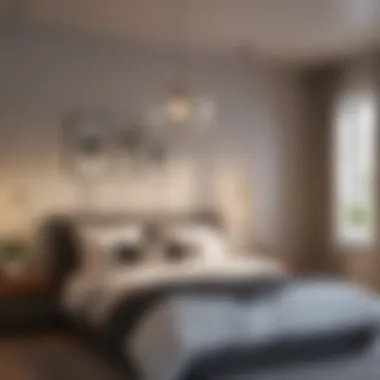
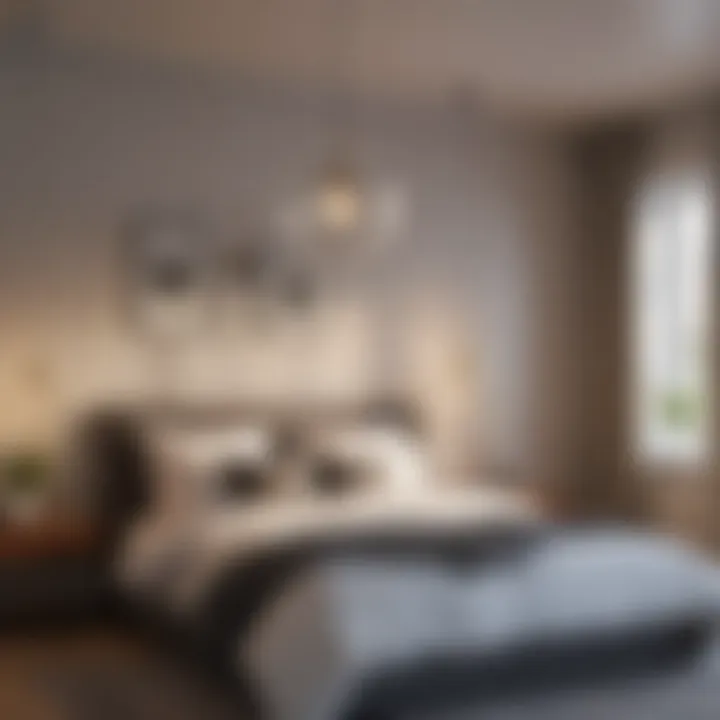
Intro
Lighting in a bedroom is more than just a basic necessity. It plays a vital role in shaping the overall ambiance of the space and serves functional purposes. A well-lit bedroom can foster relaxation and productivity alike. The right lighting can make a small room feel spacious or create intimate corners for reading. This article delves deeper into various aspects of bright bedroom lighting by discussing techniques, styles, and the interplay between lighting and interior design.
Key Insights and Trends
Current Trends in Interior Design
Bright bedroom lighting reflects current trends in interior design that emphasize both aesthetics and functionality. Minimalistic designs are emerging as popular, where less is more. Bright, natural light is preferred over dim or harsh alternatives. Using layers of light has become crucial in modern designs.
Warm white and cool white shades are prevalent, as they cater to different moods. Smart lighting systems that allow for control via smartphones add convenience and appeal to tech-savvy homeowners. The growing interest in sustainability has increased the use of energy-efficient options like LED lighting.
"Lighting can transform a space. Its presence can significantly change the mood and functionality of a bedroom."
Popular Lighting Styles
Several lighting styles capture attention. Here are a few worth noting:
- Task Lighting: Focused light sources aid in specific activities, like reading or working.
- Accent Lighting: Used to highlight art or architectural features.
- Ambient Lighting: Provides overall illumination. It sets the tone of the room.
- Decorative Lighting: Not only functional but also serves as a design element in itself.
Practical Tips and How-To Guides
Step-by-step Guides for Home Decoration Projects
To enhance bedroom lighting, follow these steps:
- Assess the Space: Note how much light enters during the day.
- Choose the Right Fixtures: Select based on the room's style and purpose.
- Layer Your Lighting: Combine ambient, task and accent lighting to create depth.
- Consider Routing and Placement: Ensure lights are positioned to maximize their effectiveness.
Entertaining Tips and Planning Checklists
For rooms where social activities occur, consider the following:
- Adjust Brightness: Use dimmers for flexibility.
- Use Warm Tones: Warm color temperatures encourage relaxation, perfect for gatherings.
- Create Focal Points: Use lights to guide attention to central features of the room.
In summary, bright bedroom lighting plays a crucial role in shaping an inviting and functional space. By understanding current trends, popular styles, and practical techniques, homeowners and renters alike can elevate their bedrooms into an oasis of comfort and utility.
Preface to Bright Bedroom Lighting
The concept of bright bedroom lighting extends beyond simple illumination; it significantly impacts the mood and functionality within the space. Adequate lighting is essential for creating an inviting atmosphere that encourages relaxation and productivity. It influences how individuals interact with their surroundings and can even affect their well-being.
Well-designed lighting can transform a bland room into a vibrant area. Lighting serves various purposes: it enhances the aesthetic appeal, supports daily activities, and sets the ambiance for different moods. Moreover, it ensures safety and ease of navigation during the night. The appropriate lighting can invigorate or soothe, depending on its placement and intensity. Thus, understanding these aspects becomes vital for any homeowner or interior design enthusiast.
Importance of Adequate Lighting in Bedrooms
The significance of proper lighting in bedrooms cannot be overstated. Bedrooms are personal sanctuaries where individuals unwind and recuperate from the stresses of the day. Therefore, the quality of light plays a critical role in fostering a serene and comfortable environment.


One crucial aspect is the impact on sleep. Poor lighting can negatively influence the body's circadian rhythm, making it difficult to rest. Soft, warm light can promote relaxation, while brighter light can stimulate alertness. Additionally, effective lighting can enhance the functionality of the bedroom. Activities such as reading or working require specific types of illumination. Task lighting is essential here, allowing individuals to perform these activities without straining their eyes.
Objectives of Bright Bedroom Lighting
The primary objectives of bright bedroom lighting include balancing aesthetics and functionality. This involves creating a visually appealing space while ensuring that the lighting suffices for various tasks. There are several goals to consider:
- Enhance Mood: Proper lighting can elevate the mood and align with the desired atmosphere, whether it's calming for sleep or bright for productivity.
- Facilitate Activities: Lighting must support activities such as reading, working, or relaxing, tailoring brightness and style accordingly.
- Highlight Design Elements: The right lighting can accentuate architectural features and decor, creating depth and focus within the room.
- Energy Efficiency: As energy costs rise, selecting efficient lighting solutions is vital. LED technology, for example, offers both brightness and efficiency, contributing to lower energy bills.
In summary, understanding the importance of bright bedroom lighting enriches personal space and enhances overall well-being.
Types of Lighting for Bedrooms
The types of lighting selected for a bedroom plays a significant role in defining both its functionality and aesthetic appeal. Different lighting strategies can drastically change how a space feels and functions. Proper lighting not only illuminates the room for daily activities but can also create a relaxing environment necessary for winding down. Understanding the different categories of lighting helps in choosing the most suitable options for personal needs and style.
Ambient Lighting Overview
Ambient lighting serves as the foundation of illumination in any room, including bedrooms. It provides overall brightness and creates a comfortable level of illumination without harsh shadows. Ambient lighting is usually achieved through ceiling fixtures, overhead lights, or even large lamps. It sets the mood of the bedroom, making it inviting and warm. Also, it plays a vital role in ensuring the space can be navigated easily and safely during nighttime.
Task Lighting Applications
Task lighting addresses specific activities that require more focused illumination. It is crucial in areas where attention to detail is necessary, such as reading or working. Task lighting can be flexible and adjustable, making it suitable for varying needs depending on the situation.
Reading Lights
Reading lights are essential for individuals who enjoy curling up with a book before sleep. They typically have adjustable features allowing the user to direct light exactly where needed. The key characteristic of reading lights is their ability to eliminate shadows on the pages while being gentle on the eyes. This makes reading before bed a comfortable experience.
A beneficial aspect of reading lights is their diversity in design. They can be found as wall-mounted sconces or free-standing lamps. Their unique feature is often the dimming capability, which allows one to control the brightness based on preference. However, one disadvantage could be the positioning; if they are not placed correctly, they might not provide the needed
Choosing the Right Fixtures
Choosing the Right Fixtures is a critical aspect when it comes to bright bedroom lighting. The fixtures you select are not just about aesthetics; they serve a functional purpose that can greatly enhance your bedroom’s overall environment. The right lighting fixtures can boost illumination, create moods, and even emphasize your interior design choices. Understanding how different types of fixtures operate and their applications can lead to better decision-making, ensuring that your lighting complements both style and purpose.
Ceiling Lights: Options and Considerations
Ceiling lights are often the foundation of bedroom lighting. They are essential for providing overall ambient light. Numerous styles exist, ranging from recessed lights to elaborate chandeliers. When selecting a ceiling fixture, consider its wattage, brightness, and design compatibility with other elements in your room. Recessed lights can provide a clean look and offer flexibility in terms of placement. Alternatively, pendant lights can add character and focal points in larger bedrooms. The height of the ceiling also influences fixture choice; low ceilings favor flush-mounted lights, while vaulted ceilings have more versatility.
Wall Sconces: A Functional Decoration
Wall sconces can provide both style and functionality. They occupy minimal space, which is beneficial, especially in smaller bedrooms. Wall sconces can also serve as accent lighting, highlighting artwork or architectural features. Consider the placement carefully; sconces should be positioned at eye level to maximize their effect. Additionally, many wall sconces now come with adjustable features or integrated LED bulbs offering energy-saving options. This makes them versatile enough for various bedroom styles, from contemporary to rustic.
Table and Floor Lamps: Versatility in Design
Table and floor lamps offer excellent versatility in design and function. They can be moved easily to adjust the light intensity in different areas of the room. For instance, a table lamp on a nightstand can provide soft lighting for reading. Conversely, a floor lamp can brighten corners, creating a cozy atmosphere. When selecting these lamps, pay attention to the design, height, and bulb type, as these factors can significantly affect light distribution and mood. Consider each lamp's placement to optimize use and enhance the bedroom’s ambiance.
"Selecting the right fixtures integrates function, aesthetic, and personality into your bedroom while optimizing light use."
In summary, the right fixtures are crucial in establishing bright bedroom lighting that meets both aesthetic desires and functional requirements. By carefully choosing ceiling lights, wall sconces, and table and floor lamps, you can create an environment that is welcoming while also suited to your needs. Avoidance of overly complicated designs ensures clarity in both taste and functionality.
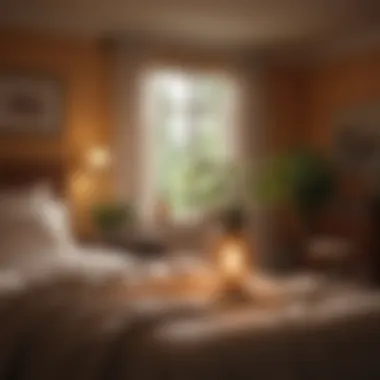

Understanding Color Temperature
Understanding color temperature is crucial for creating the right atmosphere in your bedroom. The color temperature of a light source affects how light interacts with your decor and influences the mood of the space. It aids in setting a particular ambiance, whether it's a calming retreat or a vibrant workspace. In this section, we will explore what color temperature means, its impact on mood, and how to choose the appropriate settings for your bedroom.
What is Color Temperature?
Color temperature refers to the warmth or coolness of a light source, measured in Kelvin (K). A lower Kelvin value indicates a warmer light, while a higher value signifies a cooler light. For example:
- 2700K to 3000K is considered warm white, resembling the soft glow of incandescent bulbs.
- 3500K to 4100K is neutral white, appearing more natural.
- 5000K and above is cool white or daylight, providing a bluish tint.
Understanding these ranges helps in selecting bulbs that complement your bedroom's ambiance.
Impact of Color Temperature on Mood
The link between color temperature and mood is well-documented in both psychological and design fields. Warmer lights (around 2700K to 3000K) generally create a cozy and inviting atmosphere conducive to relaxation. In contrast, cooler lights (5000K and above) promote alertness and productivity, making them suitable for workspaces.
This relationship plays a significant role when designing your bedroom:
- Warm white light fosters a soothing environment for winding down.
- Cool white light may be useful for tasks like reading or studying before bed.
Choosing the Right Color Temperature for Bedrooms
Warm White vs. Cool White
When discussing warm white versus cool white, it is essential to recognize their specific characteristics and suitable applications. Warm white (2700K-3000K) is known for providing comfort and creating a relaxed atmosphere. This is particularly useful in a bedroom, where comfort is paramount. It can enhance the beauty of warm wood finishes and rich color palettes.
On the other hand, cool white (around 4000K) offers brightness and clarity. It helps in highlighting details in modern interiors. However, it may sometimes feel too stark for those seeking a tranquil setting. Balancing these options according to your needs can be beneficial, as each has its unique appeals and drawbacks.
Adjustable Temperature Solutions
Adjustable color temperature solutions offer flexibility in lighting design. These systems allow you to change the light's Kelvin value, transitioning from warm white to cool white with ease. This adaptability makes it possible to tailor the ambiance according to different activities or times of the day.
The major advantage of such solutions is their versatility. You can create a calming environment in the evenings and a vibrant workspace during the day. However, they can sometimes be more expensive to install than standard fixed-temperature options. The initial investment often pays off in flexibility and function, making it a wise choice in modern bedroom design.
"The choice of color temperature in lighting is more than a preference; it directly affects how we feel and interact within our space."
Layering Lighting in the Bedroom
Layering lighting is a critical aspect of designing an inviting bedroom atmosphere. It involves the strategic combination of different types of lighting to fulfill various needs and enhance the overall appearance of the space. The importance lies in creating a flexible environment that can adapt to activities, moods, and even times of day. By utilizing multiple layers—ambient, task, and accent lighting—one can create a dimensional and dynamic room.
What is Lighting Layering?
Lighting layering refers to the practice of using different sources and types of light within a space. Each layer serves a distinct purpose, contributing to both the functionality and the aesthetic appeal of the bedroom. Ambient lighting illuminates the entire room, while task lighting targets specific activities, such as reading or working. Accent lighting, on the other hand, highlights certain features or decor elements. This combination is not just practical; it enriches the visual experience of the bedroom.
Creating Depth with Multiple Layers
Incorporating multiple layers of lighting can add depth and warmth to the bedroom. A well-layered lighting scheme can transform the way the room feels and functions. For instance, while ambient light sets the foundation, specific task lights can accentuate workspaces or reading nooks. Accent lighting allows for the highlighting of artwork or architectural features, ensuring they do not go unnoticed. The interplay of various light sources provides versatility, allowing individuals to customize the ambiance based on their needs.
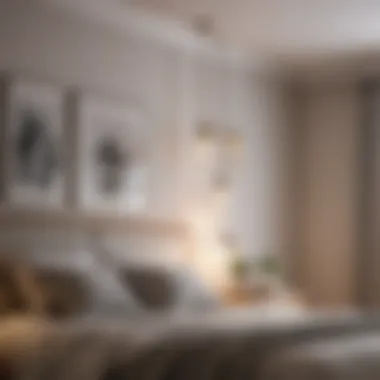
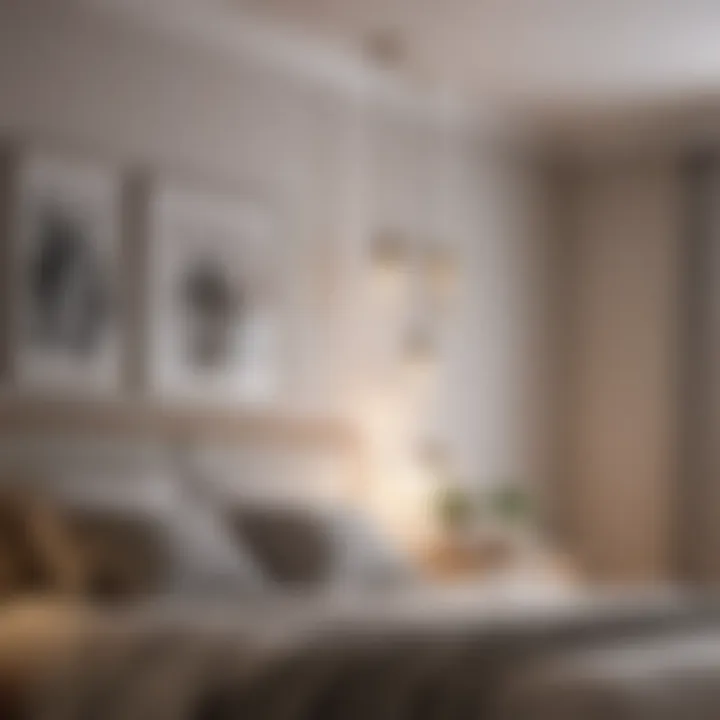
Practical Tips for Layering Light
Using Dimmer Switches
Using dimmer switches is a practical approach to enhancing the flexibility of your lighting system. These devices allow for adjustment of light intensity, offering control based on mood, occasion, or time of day. This key characteristic makes dimmer switches a popular choice. They help create a serene environment during nighttime while still providing brightness during daytime activities. One advantage of dimmer switches is their compatibility with various types of lightbulbs, including LEDs. However, a potential disadvantage is that some dimmers may not work well with older type bulbs, leading to flickering or reduced functionality.
Combining Different Types of Lights
Combining different types of lights is essential in crafting a comprehensive lighting strategy. By blending ambient, task, and accent lights, one can achieve a well-rounded lighting scheme. The main characteristic of this approach is its ability to provide both functionality and aesthetics; the right combination can make a bedroom feel cozy and multidimensional. An advantage of this method is the added versatility; different settings cater to various activities, from relaxing to working. Still, careful planning is necessary, as overly mixed styles can create a disorganized appearance if not aligned with the overall design theme.
Energy Efficiency in Bedroom Lighting
Energy efficiency in bedroom lighting is more than just a trend; it is a necessity. As energy costs rise, many homeowners are exploring ways to manage expenses between maintaining comfort and control over their living environment. In this section, we will explore key aspects, benefits, and considerations associated with energy-efficient lighting options.
Understanding Energy Efficient Bulbs
Energy-efficient bulbs give a valuable alternative to traditional incandescent lamps. These bulbs utilize less electricity while providing equal or greater illumination levels. The most common type of energy-efficient bulb is the LED. LEDs can last significantly longer than incandescent and compact fluorescent lamps. In fact, they can have a lifespan of around 25,000 to 50,000 hours, compared to 1,000 hours for incandescent bulbs.
When selecting energy-efficient bulbs, it is essential to consider lumens instead of watts. Lumens measure brightness, while watts indicate the energy used. For example, a 10-watt LED can emit the same brightness as a 60-watt incandescent bulb while consuming much less power.
Benefits of LED Lighting
The shift to LED lighting also comes with several benefits:
- Longevity: LEDs last longer, reducing the frequency of replacements.
- Energy Savings: Switching to LED can lead to significant savings on electricity bills—up to 80% less energy use.
- Lower Heat Emission: Unlike incandescent bulbs, LEDs emit very little heat, reducing cooling costs in warmer months.
- Environmental Impact: Using less energy means lower carbon footprints. This aspect appeals to eco-conscious individuals.
"Choosing LED lighting makes not only financial sense but also benefits the environment overall."
Eco-Friendly Practices for Lighting Usage
In addition to using energy-efficient bulbs like LEDs, there are various practices to enhance energy efficiency in bedroom lighting:
- Use Dimmer Switches: Dimmer switches help in controlling the light and adapting it to different needs.
- Utilize Natural Light: When possible, allow natural light to illuminate the bedroom during the day, reducing reliance on artificial lighting.
- Smart Lighting Systems: Sensors and smart lighting can automatically adjust based on room occupancy, ensuring lights are used only when needed.
- Regular Maintenance: Keeping fixtures clean ensures maximum light output, which can contribute to energy conservation.
All these practices, coupled with proper bulb selection, can significantly lower energy consumption and enhance the lighting experience in bedrooms.
The End: Crafting Your Ideal Bright Bedroom Lighting
Creating the perfect lighting in your bedroom is more than a mere choice of bulbs or fixtures. It involves understanding the interplay between various lighting types, color temperature, and energy efficiency. This conclusion synthesizes the insights provided in this article, emphasizing the importance of a mindful approach to bedroom lighting.
Bright bedroom lighting serves both aesthetic and functional purposes. It enhances the atmosphere, making the space more inviting, while also supporting daily activities, such as reading or getting dressed. By balancing ambient, task, and accent lighting, you can define the character of your room and adapt it for different occasions. Moreover, energy efficiency should not be overlooked. Opting for LED lights and employing eco-friendly practices can lead to significant savings in energy costs and a reduced carbon footprint.
Summarizing Key Points
- Adequate Lighting is Crucial: Proper lighting is fundamental. It influences mood, functionality, and overall comfort in a bedroom.
- Diverse Lighting Types: Ambient lighting provides overall illumination, task lighting focuses on specific areas, and accent lighting emphasizes design features.
- Color Temperature Matters: Warmer tones can evoke relaxation, whereas cooler tones may enhance alertness. Choosing the right temperature is key for your intended vibe.
- Layered Lighting Technique: Using multiple lighting layers adds depth and versatility to your bedroom, making it suitable for various activities.
- Energy Efficiency is Beneficial: Utilizing energy-efficient bulbs like LEDs can reduce consumption and promote sustainable living.
Final Thoughts on Implementation
Implementing the suggestions for bright bedroom lighting can be straightforward and rewarding. Start by assessing your bedroom's current lighting state. Identify areas that lack sufficient light or could benefit from a design update. Consider integrating dimmer switches for flexibility in brightness, allowing you to adjust the atmosphere as needed.
Incorporate various lighting fixtures and styles. For instance, combine sleek ceiling lights with elegant wall sconces and versatile table lamps to create an inviting space. To enhance the aesthetic appeal, deliberately place accent lighting to highlight artwork or architectural features.
In summary, crafting your ideal bright bedroom lighting involves thoughtful consideration of your space's needs. By employing a combination of lighting techniques, including understanding color temperature and embracing energy efficiency, your bedroom can become a harmonious blend of functionality and beauty.



